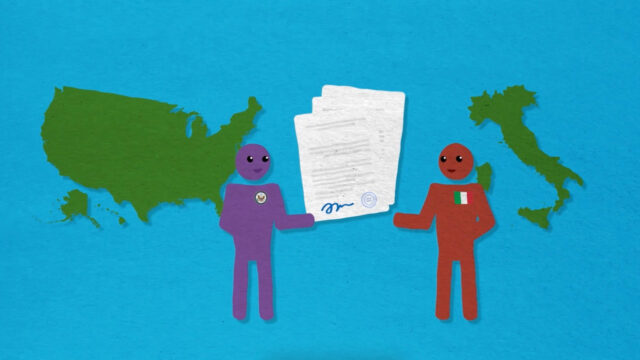What Are Treaties and Alliances? Page URL copied to clipboard!

Treaties and alliances are two ways the United States formalizes agreements with other countries and international organizations. Treaties are written agreements between nations or between nations and international organizations. Alliances are formal agreements where countries pledge to help one another in a time of need.
In this video, you will learn how treaties and alliances help nations build formal relationships. These agreements address different global issues. From copyright protection to border disputes, the United States is part of many treaties and alliances.
Discussion Questions
Use the following discussion questions to guide your classroom conversations about this video. Refer to the timestamps to find the answers to these questions.
- How do countries formalize the agreements they make with other countries? (start – 1:00)
- What are some topics often focused on in treaties or alliances? (start – 0:30)
- Explain the two types of treaties identified in the video. (1:00 – 1:30)
- How do countries benefit from alliances? (3:05 – 3:25)
- In what ways do alliances like NATO benefit the world? (3:25 – 3:45)
- Explain what this quote means: “Without treaties and alliances, the United States could not work effectively with other countries to accomplish our mutual goals of security and prosperity.” (2:20 – end)
- What are some of the country flags represented in this video?
- Identify some current treaties and alliances of the United States.
- What is one thing you learned from the video that you found interesting, surprising, or confusing?
- Summarize what you learned about treaties and alliances.
Video Vocabulary
The following terms are referenced in this video.
- Treaty – A contract or agreement between countries.
- Alliance – An agreement made for the mutual benefit of two or more countries.
- Territorial boundaries – A country’s borders.
- Human rights – Individual rights that belong to every person and are not granted by a government.
- Law enforcement – Organizations that work to keep public order and public safety.
- Environmental – Of the natural world.
- Process – The steps you take to do something.
- Outcome – The results of actions.
- Mutually Binding – An agreement between two or more parties that is written and enforceable by laws or treaties.
- Formal – Proper or official actions.
Related Classroom Activities
Continuity and Change Over Time
Analyzing how people, ideas, systems, groups, events, and things change over time is a valuable skill for understanding the past, present, and future. In this… Also available in Español
Learn Diplomatic Terms with the Frayer Model
This activity uses the Frayer Model to provide a multi-modal approach to learning vocabulary related to diplomacy. This document includes slides for 63 terms related… Also available in Español
Mini Object-Based Learning Activity
This 15-minute activity uses an object from the National Museum of American Diplomacy’s collection and a video to teach students concepts of diplomacy. This activity… Also available in Español
Object Choice Board
This activity uses an object from the National Museum of American Diplomacy’s collection and a video to teach students concepts of diplomacy. This activity is… Also available in Español


